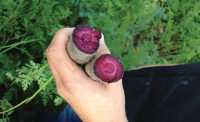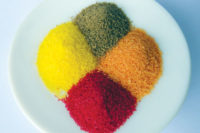2020 PREDICTIONS: COLORANTS
Color Technologists are Creating Safe,Stable, Long-Lasting Natural Colors
In many cases, suitable "one-for-one" synthetic food colorant replacements do not exist

The shift to natural colorants is easier than ever with more stable, longer-lasting colors.
PHOTO COURTESY OF: Getty Images
Recent trends in the food industry have favored the use of naturally derived food colorants at the expense of synthetic food coloring ingredients. This has been welcomed by consumers and activists, but it has presented challenges to food manufacturers. Primarily, natural colorants suffered from a lack of vividness, consistency, and shelf life.
Finding suitable replacements for synthetic food colorants can be straightforward but in many cases no suitable “one-for-one” replacement exists. Often, a manufacturer must accept a difference in shade, a higher cost of use, or a shorter practical shelf life.

Check out our December 2019 issue for more food & beverage predictions!
As an example, FD&C Yellow #5 is a bright yellow color popular in many food applications, including beverages, confections, and other prepared foods. It also has been identified as a sensitizer for a segment of the consuming public, which means that its use requires a specific warning on food labels.
Turmeric oleoresin is a well-known spice extract, and, in its purified form (curcumin), is an exceptionally good shade match to Yellow #5. Moreover, it has also been shown to have positive physiological effects, including both antioxidant and anti-inflammatory activities.
However, turmeric oleoresin is only sparingly soluble in either water or oil, which complicates its incorporation into certain food products. More importantly, while Yellow #5 is very stable in light, turmeric oleoresin is notoriously unstable under direct light. It degrades rapidly into colorless byproducts unless the food is packaged in opaque containers.
The Natural Brigade
FD&C Red #40 has been a popular red color in food applications for decades. As synthetic colorants go, it is one of the larger volume food colorants produced. There are several naturally derived colorants that also give a red color in food and beverage applications, but all have some performance limitations relative to Red #40.
For example, anthocyanin-based food colorants (derived from plant sources such as red cabbage, red grapes, red radish, purple sweet potato, black carrot, and many berries) function well in low-pH beverage applications, but generally lose color intensity or change shade when exposed to higher pH’s. Their shades vary somewhat between sources, so this variety can be advantageous when attempting to mimic the color shade of Red #40. They are more expensive on a cost in use basis compared to Red #40.
Caramel colorants have received a lot of attention since they were included on California’s Prop 65 list due to the presence of 4-methylimidazole. Caramel colorants are used in large volumes in food and beverage products such as colas and baked goods, where they give appealing brown and tan shades. They are inexpensive and perform well under a variety of conditions. Other naturally-derived alternatives are substantially more expensive in use, at least partly because of their low tinctorial power.
Natural green and blue colorants are only more recently coming into more common use in foods and beverages due to limitations related to stability and regulatory issues. Chlorophyll, for example, is quite sensitive to heat, light, and pH. Spirulina extract is derived from a blue-green algae, and it provides an attractive natural blue color. However, it suffers from the same sensitivities as chlorophyll. Spirulina is also expensive to use.
Up and Coming
Given the abundance of color shades in nature, it is tempting to believe one can easily find a natural source of any shade desired. The problem is that the permitted sources of food-grade natural colorants are limited to those either known to be edible (such as grapes) or having a long history of safe use and thus have been “grandfathered” into current legislation (such as paprika oleoresin).
Recently, even well-known and commonly used natural colorants like annatto and turmeric oleoresin have been revisited and subjected to more rigorous safety evaluations due to consumer and regulatory concerns. This means that finding truly new natural colorant options with better functionality in demanding food and beverage applications is an expensive process.
That said, there are a number of new food and beverage colorants available. An iron oxide based red pearl pigment that is heat and light stable and approved for confections was just launched. Also, a silica-based pearl color has been introduced and is expected to be approved soon for all applications. Other pearl colors have application restrictions. A navy blue color made from a blend of extracts of the South American huito fruit (Genipa americana) and watermelon juice recently debuted and already is being used in a number of applications. A petition has been filed for another blue colorant, derived from the flower of the butterfly pea (Clitoria ternatea), already in common use in Asia. And a new, stable, natural red replacement for Red #40 is scheduled to debut next year, so stay tuned.
Science Steps Up
The powerful consumer- driven push to shift toward natural flavors and colors in light of the aforementioned challenges kicked ingredient scientists into overdrive. This diligence has paid off with marked innovations in performance. Advances in the understanding of how natural colorants interact with their matrix and how formulation and processing conditions can affect their stability have led to what amounts to a timely shot in the arm for natural colorants.
One of these advancements is evident in the new generation of colorants derived from red beet. Red beet colorant provides an appealing berry-red color in applications such as ice cream and powdered beverages. But it degrades quickly under heat stress.
For this reason, beet red behaves relatively well in low-water-activity applications, such as powdered beverages. It can also give a bright red color to hard-boiled candies when it is incorporated late in the process (when the water activity is low even though the heat level is high).
However, color formulators discovered other ways to improve the heat stability of red beet color. The addition of other food-grade ingredients that act to shield the red beet color from the more damaging effects of heat has resulted in more stable commercial products. Beet color can now be stabilized effectively against high temperature conditions and in under relatively harsh storage conditions.
Turmeric oleoresin’s exceedingly low solubility in water made it necessary to dissolve or emulsify turmeric using surfactants, such as polysorbate 80, to achieve an acceptable color intensity. With the proper formulation it is possible to achieve brightly yellow colored beverage formulations. But polysorbate 80, while being a great emulsifier, is a synthetic ingredient and increasingly rejected by consumers.
It was discovered that purified turmeric oleoresin in solid form can be milled into hyperfine particles that deliver a desirable yellow color when dispersed in liquid media like water or milk. The use of food grade, natural emulsifiers to support the dispersion then allow for production of good quality turmeric food colorant formulations. These are much more stable under light than the older types of emulsified formulations.
In addition to developing stronger and more intense natural color shades, there also has been considerable work done on improving color stability. Some of this comes from selection of raw material. For example, newer di-acylated anthocyanins, such as purple sweet potato and red cabbage, are more stable than mono-acylated or non-acylated traditional anthocyanins such as from grape and elderberry.
Various colors are stabilized using natural antioxidants, such as vitamin C (ascorbic acid), the tocopherol form of vitamin E, and botanicals (such as rosemary extract) or by combining them with natural co-pigments. Some work has also been done to improve stability via encapsulation or the use of particular carriers.
These developments represent progress in the stabilization of naturally derived food colorants, extending their utility in food and beverage applications. It is hoped that the extension of these types of technologies and understandings, along with new and as-yet-undiscovered secrets to their performance, will continue to expand the utility of this important and growing class of food ingredients.
Originally appeared in the December 2019 issue of Prepared Foods as Color Safe.
Looking for a reprint of this article?
From high-res PDFs to custom plaques, order your copy today!






